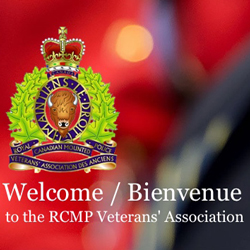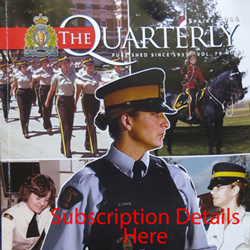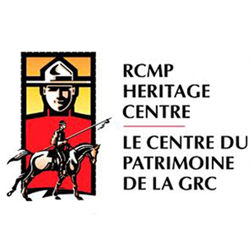Ric Hall: Who Was The Last RNWMP Commissioned Officer
Over the course of the history of the Force there have been many firsts and lasts! First car, first female members, last dog and horse patrol, last troop to train in “N” Division, last troop to take equitation training, first cadets in training and there are so many others. There also has to be a first and last members who were to be sworn in to the NWMP, RNWMP and the RCMP.
Hopefully, there will never to a “last” member sworn into the RCMP. Those who are interested in the history of the Force know who the first members were to be sworn into the Force, but there is often confusion as to when the first members were sworn into the Force. Apparently some were signed on in eastern Canada as early as September and October of 1873. But the official date of the swearing in of the first members of the NWMP is November 03, 1873. The first three members to take the oath November 03, 1873, but they did not end up as Regimental #s 1, 2 & 3, were:
The individual careers of these three men is deserving of their own story, for a later time.
The first officer was William Drumer Jarvis, 0.2, Sept 25, 1873. When officer #s were later assigned 0.1 was given to Commissioner French. Superintendent Jarvis’ “service disposed with” August 13, 1881.
This brings me to, who was the last officer commissioned in the North West Mounted Police two officers may lay claim to being the “last.” Both William Pennefather and Albert Shaw were commissioned in June of 1904, just prior to the Force becoming the Royal North West Mounted Police. Their careers and stories took totally different paths. Pennafather being a long serving member of the Force and Shaw’s time was very short term, joining with a commission (JWC) and leaving a few days later.

Photograph of Sergeant Major Percival William Pennefather (Reg.#1148 – O.139) (Source of photo – RCMP Historical Collections Unit – “Depot” Division).
Percival William Pennefather, Regimental # 1148, came to Regina as a raw recruit in the troubled days of 1885, Pennefather was destined to spend the next thirty-seven years with the Force, experiencing many of its triumphs and many of its vicissitudes. He signed up as a twenty year old March 16, 1885. He was promoted to Corporal, December 1, 1887 and March 11, 1890 to Sergeant. He spent some years at Wood Mountain and served also at Battleford and MacLeod. In March of 1896, he was promoted to Sergeant Major and In July 1899, left for the Yukon where he remained for five years. In June 1904, he was appointed Inspector (O.139) and transferred to the Prince Albert District.
It appears Pennefather was, according to Archive Records, the last officer commissioned into the North West Mounted Police. Ironically, Archives have a lot of information on most officers, but nothing on Pennefather. Internet sources indicate that he served 38 years, joining the NWMP in 1885, served during the 1885 Rebellion, spent seven years in the Yukon, retired in August 1922 as a Superintendent. He died in 1942. Pennefather’s son, John Pyne Pennefather, was Reg # 6726, RNWMP, apparently he served for eight months and left to serve in WWI.
Not to confuse matters but O.140, Alfred Shaw, was commissioned 1904-06-20, but resigned 1904-06-30. So it could be argued he was the last commissioned officer of the NWMP. A very short career. Why…who knows? He died in WWI see below.
Alfred Shaw, Joined With Commission (JWC), the NWMP, (O.140) June 1904, and along with Percival Pennefather (O.139) were the last two officers commissioned in the NWMP. Shaw left the NWMP ten days after he joined. Reason unknown, he probably did not even have time to draw his kit, so personally I give the nod to Pennefather as the last commissioned officer of the NWMP.
Little is known about Alfred Shaw’s career after leaving the Force until his service during the Great War, World War I. Lieutenant Colonel Alfred Earnest Shaw was born in Millbrook, Ontario, on November 21, 1881, and served his country his entire life.
Initially commissioned into the 3rd Dragoons, a militia unit, Shaw soon transferred to active duty with the Northwest Mounted Police and later on, with Strathcona’s Horse.
When the war began he raised and initially commanded the 6th Canadian Mounted Rifles, but as the various units were being amalgamated overseas Shaw was transferred over to the 1st Canadian Mounted Rifles (1 CMR). He assumed command of this unit a short while later.
In December, 1915, the C.M.R. were turned into infantry and brought up to infantry strength, the 3rd C.M.R. being divided the 1st and 2nd C.M.R. and 4th and 5th, the four battalions becoming the 8th Brigade, C. E. F.
As Col. Shaw’s regiment had been absorbed he was offered the command of the 1st C.M.R., senior officers foregoing their seniority so he could come to the battalion. He commanded the battalion with marked success until he was killed in action on June 2, 1916.

1916 – Photograph after the battle of Battle of Mont Sorrel. Photo illustration created by the German artillery.
The 3rd Canadian Division was severely attacked by the Imperial German Army’s XIII (Württemberg) Corps at Mount Sorrel in the Ypres salient. 1 CMR was defending the section of the front line when it was subjected to one of the most severe sustained enemy artillery bombardments in the war. Despite putting up a fierce resistance, the unit’s defensive positions were overrun by the enemy. Lieutenant Colonel Shaw was last seen with Major Fred Palmer, Officer Commanding C Company 1 CMR, organizing what remained of his battalion to make a last stand. The Battle for Mount Sorrel raged for nearly two more weeks and although the Canadians eventually retook the salient, many men, including Lieutenant Colonel Shaw, were never found.
According to the book entitled “The 4th Canadian Mounted Rifles: 1941 – 1919 (page 19-20) “For the 4th C.M.R. it was a day of obliteration. Only three officers out of twenty-two came back from the trenches. Seventy-three men out of 680 answered to their names on June 4th. General Mercer’s body was afterwards found in Armagh Wood and buried at Poperinge. Brig.-General Victor Williams (ex-RNWMP member), who was very seriously wounded, and Lieut-Colonel Usher were trapped in the “Tunnel” and fell into the enemy’s hands.
The 1st C.M.R. on the left had an equally bad time and their casualties were almost as heavy. The 5th C.M.R. which so nobly supported the Brigade in Maple Copse, was also cut up. Both of their Battalions lost their commanding officers. Liu.-Colonel A.E. Shaw of the 1st C.M.R., and Lieut.-Colonel G.H. Baker of the 5th C.M.R. fell in action.”
For a while it was assumed that he was taken prisoner. It was eventually learned that he had been killed.

Photograph of the name of Lt. Colonel Alfred Earnest Shaw as it appears on the Menin Gate (Ypres) Belgium. The gate contains the name of over 50,000 British and Commonwealth soldiers who died in World War I and whose bodies were never recovered (Source of photo – Sheldon Boles).
From the 8th annual Scarlet and Gold Magazine.
“On that terrible day one officer and 60 men of his unit came out of that disastrous engagement. The enemy had concentrated 1,000 guns on that particular mile and a half of trench and simply blew the battalion off the face of the earth.”
A typed letter of thanks from Lieutenant Colonel (later Major General) A.C. Macdonell dated September 25, 1914 expresses his personal gratitude to Shaw, a noted horseman and rider, for, “good work reference the horsing up of the [Lord Strathcona’s Horse (Royal Canadians)] – thanks to your energy, good judgment, and tact, we will go to England well horsed.” The hand written personal will of Shaw, which he wrote on November 1, 1915 after arriving in France – its content simply remarkable. “My horses are to be sold at public auction”, Shaw instructed, “with the exception of Molly McGuire which I leave to Douglas Cameron of Lord Strathcona’s Horse who will pay $100 to my estate for her keep…” Lieutenant Colonel Shaw owned a number of horses, including his favourites Tony, Buglar, Chocolate, Soldier, and Chestnut, all of which he instructed to be sold off or given away. Interestingly, however, Shaw could not bear the thought of someone else deciding the fate of “my favourite polo pony”, which he ordered “was to be chloroformed and shot” in the event of his death. Beyond his horses, Shaw left all of his remaining saddles, personal effects, money, as well as a sizeable amount of land to his beloved wife Katherine.
Lieutenant Colonel Shaw was a respected and well-liked Commanding Officer who led from the front and fought alongside his men. His death resulted in a number of very personal letters of condolence to his wife, the earliest among these being penned on 18 June 1916 while sporadic fighting was still underway at Mount Sorrel and the surrounding Ypres Salient. A short note from A.C. Macdonell to Mrs. Shaw highlighted her husband’s gallantry in action on several occasions, “in particular when he saved the aviator and we all hoped he would receive the V.C.” What event Macdonell was referring to exactly is still unknown, but it provides yet another facet of this gentleman’s career.
The receipt of a death notice came as a terrible blow to families back home in Canada, made worse still when the body of a loved one had not been recovered. Front line units, however, attempted to soften the blow when possible, and the collection of papers includes letters to Mrs. Shaw from soldiers who had served under her husband’s command. A note from rifleman Charles Cole, written from his recovery bed at No.3 Canadian General Hospital at Boulogne sometime in June or July 1916, is particularly touching:
Dear Mrs. Shaw,
May I be allowed as a wounded private in your late husband’s regiment to offer you my deepest sympathy in your great bereavement.
When I first went to Canada ten years ago Colonel Shaw, then Inspector in the mounted police, was the first Canadian to give me a helping hand. Owing the ten years I spent in Canada, I never forgot the good advice and assistance he gave me, then a stranger in a strange land. It was therefore extremely gratifying to know that he had been appointed C.O. to the battalion in which I was serving.
Never was there a more popular or respected Commanding Officer. It was a common feeling throughout the battalion, that it was entirely due to the good advice and excellent management of our colonel that the casualties of the battalion were kept so low during the earlier part of our tour in the salient, and I don’t think there were any of us but would have gone anywhere with him, as like all good soldiers he never asked a man to do anything he wouldn’t do himself.
I hope you will not consider me presumptuous in writing to you, but I felt that I must let you know how deeply we in the ranks that are still alive, sympathize with you and ourselves mourn a very gallant officer whom we shall never forget.
Yours very truly,
C.S. Cole 108158
Courtesy of the Laurier Centre for Military Strategic and Disarmament Studies.


 March 1, 2015
March 1, 2015 
















